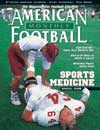AMERICAN FOOTBALL MONTHLY THE #1 RESOURCE FOR FOOTBALL COACHES
Article CategoriesAFM Magazine
|
Emergency Situations: What\'s the Coach\'s Role?© More from this issueFootball is a collision sport and by its very nature invites injury. Participation in football requires all out exertion. There are numerous situations involving oftentimes high speed contact with other bodies or with the ground. While coaches focus on strategy and victory, they also must be aware of injury risks and know their role when a situation does transpire. Fortunately most injuries do not result in emergency situations, however, when emergencies do occur, prompt care is essential. With sports medicine, just as in football, the adage "proper preparation prevents poor performance" holds true. With advance preparation, everyone is prepared to deal with emergencies when they occur. In the best scenario, coaches can rely on a sports medicine staff, complete with certified athletic trainers and a team physician to handle e....The full article can only be seen by subscribers. Subscribe today!
|
|
|||||||
| HOME |
MAGAZINE |
SUBSCRIBE | ONLINE COLUMNISTS | COACHING VIDEOS |
Copyright 2025, AmericanFootballMonthly.com
All Rights Reserved





